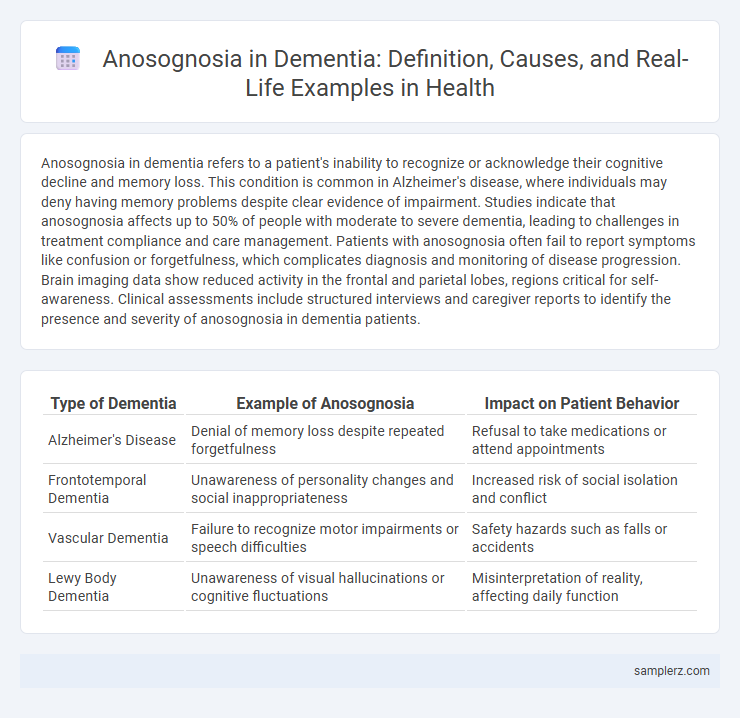Anosognosia in dementia refers to a patient's inability to recognize or acknowledge their cognitive decline and memory loss. This condition is common in Alzheimer's disease, where individuals may deny having memory problems despite clear evidence of impairment. Studies indicate that anosognosia affects up to 50% of people with moderate to severe dementia, leading to challenges in treatment compliance and care management. Patients with anosognosia often fail to report symptoms like confusion or forgetfulness, which complicates diagnosis and monitoring of disease progression. Brain imaging data show reduced activity in the frontal and parietal lobes, regions critical for self-awareness. Clinical assessments include structured interviews and caregiver reports to identify the presence and severity of anosognosia in dementia patients.
Table of Comparison
| Type of Dementia | Example of Anosognosia | Impact on Patient Behavior |
|---|---|---|
| Alzheimer's Disease | Denial of memory loss despite repeated forgetfulness | Refusal to take medications or attend appointments |
| Frontotemporal Dementia | Unawareness of personality changes and social inappropriateness | Increased risk of social isolation and conflict |
| Vascular Dementia | Failure to recognize motor impairments or speech difficulties | Safety hazards such as falls or accidents |
| Lewy Body Dementia | Unawareness of visual hallucinations or cognitive fluctuations | Misinterpretation of reality, affecting daily function |
Understanding Anosognosia in Dementia
Anosognosia in dementia manifests as a patient's lack of awareness about their cognitive deficits, such as memory loss or impaired judgment, complicating disease management and treatment adherence. This unawareness is linked to damage in brain regions like the right parietal lobe and frontal cortex, which are crucial for self-monitoring and insight. Assessing anosognosia through clinical tools like the Anosognosia Questionnaire-Dementia (AQ-D) aids clinicians in tailoring interventions and improving care strategies for affected individuals.
Common Manifestations of Anosognosia
In dementia, anosognosia commonly manifests as a patient's unawareness of memory deficits, impaired judgment, and difficulties with daily activities such as managing finances or personal hygiene. These patients often deny cognitive decline despite clear evidence from caregivers or clinical assessments. This lack of insight complicates treatment adherence and caregiving strategies, making early recognition critical for effective management.
Behavioral Signs of Unawareness in Dementia
Behavioral signs of unawareness in dementia, such as anosognosia, include the patient's denial of memory loss, refusal to acknowledge cognitive deficits, and neglect of personal hygiene or safety precautions. These behaviors often manifest as repetitive questioning, disorientation, and resistance to help despite clear evidence of impairment. Recognizing these signs is essential for caregivers to provide appropriate support and manage risks effectively.
Case Studies: Real-Life Examples
Case studies of anosognosia in dementia frequently highlight patients unaware of their cognitive decline, such as individuals with Alzheimer's disease who deny memory loss despite repeated failures in daily tasks. One documented example involves an elderly patient who insisted on living independently despite clear evidence of functional impairment and frequent safety risks. These real-life cases underscore the challenges caregivers face when managing anosognosia, complicating treatment adherence and care planning.
Impact on Daily Living and Safety
Anosognosia in dementia often leads to unawareness of memory loss or cognitive deficits, severely impacting daily living by causing patients to neglect personal hygiene, medication management, and meal preparation. This lack of insight increases safety risks, such as falls, wandering, or misuse of household appliances, necessitating constant supervision or environmental modifications. Caregivers must implement tailored interventions to mitigate dangers and support functional independence while addressing behavioral symptoms linked to anosognosia.
Differences between Denial and Anosognosia
Anosognosia in dementia is characterized by a neurological deficit where patients are unaware of their cognitive impairments, unlike simple denial which is a psychological defense mechanism. Patients with anosognosia genuinely lack insight into their condition due to brain dysfunction, often affecting the frontal and parietal lobes. Denial involves conscious refusal to acknowledge symptoms, whereas anosognosia is an involuntary and persistent inability to recognize deficits.
Caregiver Challenges and Anosognosia
Caregivers of dementia patients with anosognosia face significant challenges due to the patient's lack of awareness about their cognitive impairments, often leading to resistance against assistance and treatment. This unawareness complicates daily care routines, increases caregiver stress, and necessitates specialized communication strategies to ensure patient safety and adherence to medical advice. Effective management requires tailored interventions that address both the caregiver's emotional burden and the patient's denial of their condition.
Strategies for Managing Anosognosia
Strategies for managing anosognosia in dementia include structured environmental modifications to reduce safety risks and enhance independence, use of consistent routines to minimize confusion, and employing gentle redirection techniques when patients deny their cognitive deficits. Caregiver education is essential to recognize anosognosia symptoms and implement communication approaches that avoid confrontation while promoting cooperative behavior. Incorporating professional support such as occupational therapy and psychological counseling further aids in adapting management plans tailored to the severity of anosognosia and dementia progression.
Medical Assessment and Diagnosis
Anosognosia in dementia often manifests as patients denying or unaware of their cognitive deficits, complicating clinical evaluation. Medical assessment involves structured neuropsychological tests combined with informant interviews to differentiate anosognosia from memory loss or denial. Neuroimaging techniques like MRI and PET scans support diagnosis by identifying neural correlates of self-awareness deficits in regions such as the frontal cortex.
Supporting Persons with Anosognosia in Dementia
Supporting persons with anosognosia in dementia requires tailored interventions that address their lack of awareness about cognitive deficits. Care strategies often include consistent routines, gentle reassurance, and involvement in decision-making to reduce confusion and resistance to care. Employing empathetic communication and validated assessment tools improves cooperation, enhances safety, and promotes better quality of life.

example of anosognosia in dementia Infographic
 samplerz.com
samplerz.com